Tab5 Home Assistant HMI 案例
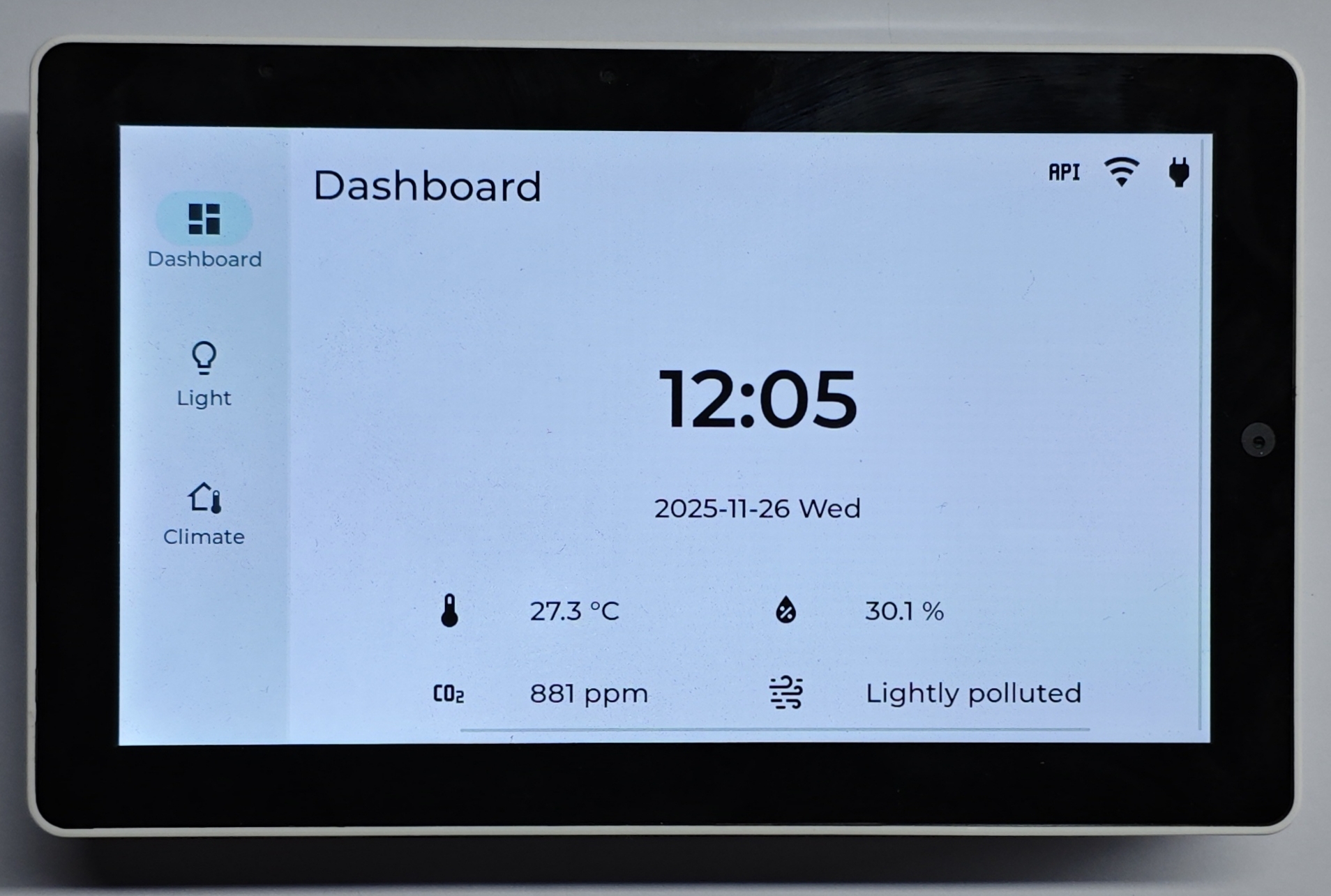
本文将展示一个把 Tab5 变为一个 Home Assistant 人机交互设备
在这个案例中我们会用到几个 Home Assistant 中的实体,主要是温湿度传感器 (Unit ENV-Pro),一个RGB灯 (Unit NeoHEX) 和一个红外远程空调实体。
如需参考以上设备的 ESPHome 配置(需要额外的控制设备,本案例使用的是 Atom EchoS3R 作为平台,来集成温湿度、灯光和红外组件):
2025.10.3 下编译,如果遇见编译或上传问题,考虑将 ESPHome 切换至此版本2. 案例仅做为演示,配置文件的内容可能更改。对于在2025年10月14日之后生产的产品,LCD/触摸屏的 IC 已被更换为 ST723,目前的配置暂不支持该 IC,我们会持续优化驱动支持
准备工作
- 一台 Home Assistant 主机
- 安装并且启用了 ESPHome Builder 加载项
- 确保之前提到的实体已经被集成至 Home Assistant 中
在 Home Assistant 中打开 ESPHome Builder,创建一个空的配置文件
点击右下角的
NEW DEVICE按钮弹出框单击
CONTINUE
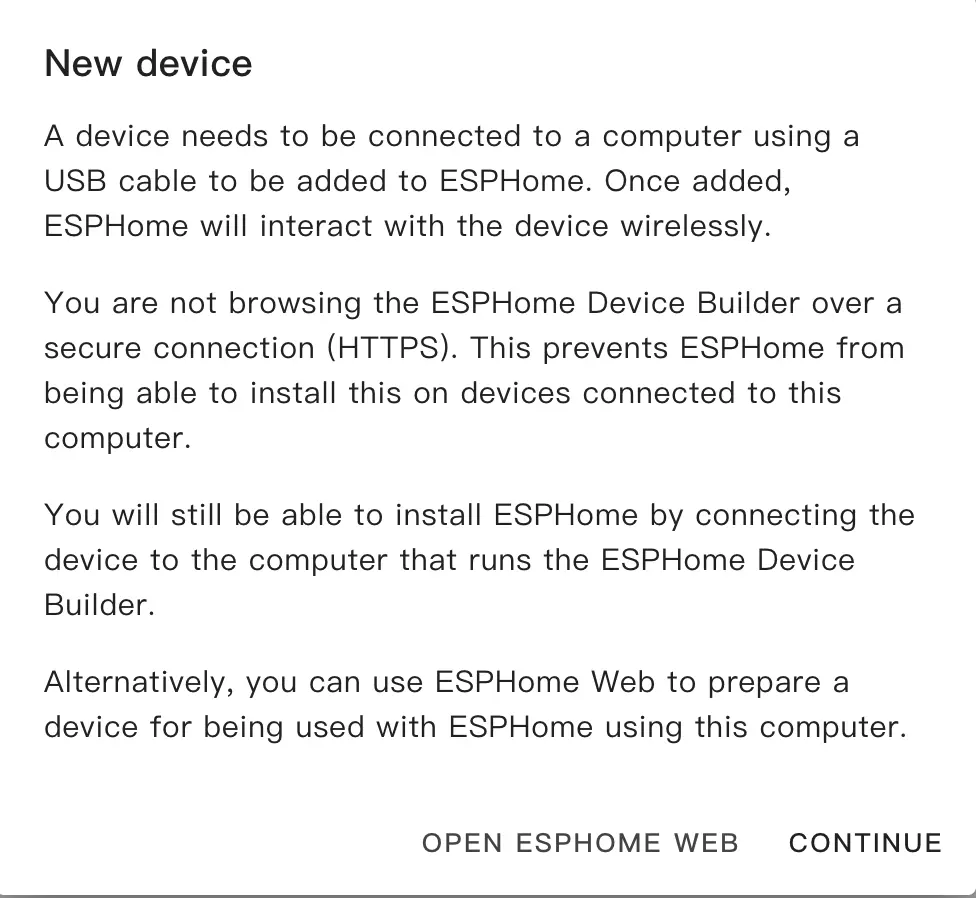
- 选择
Empty Configuration
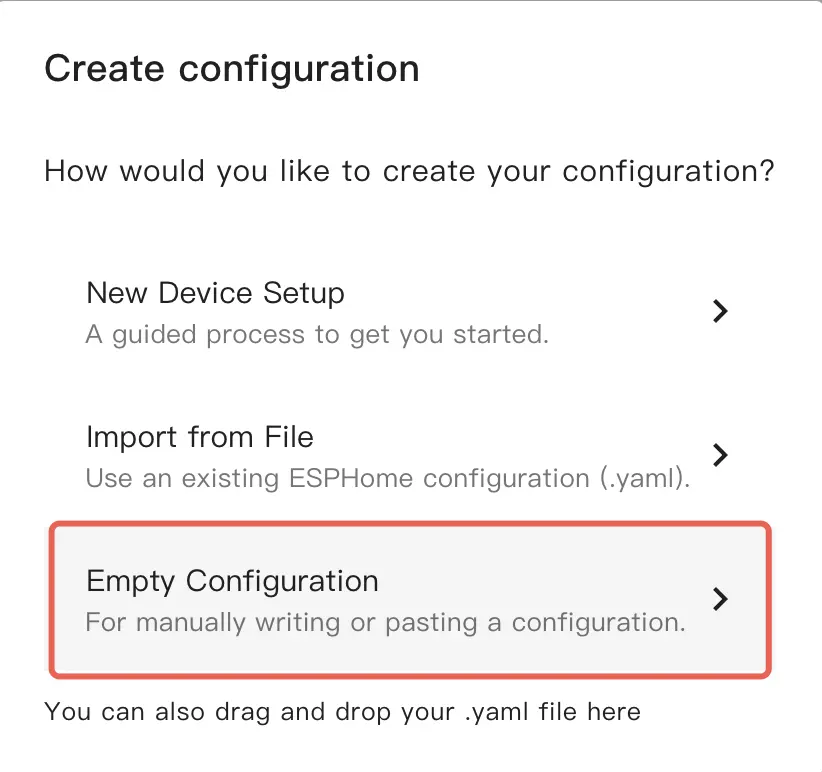
- 为文件命名 (可选)
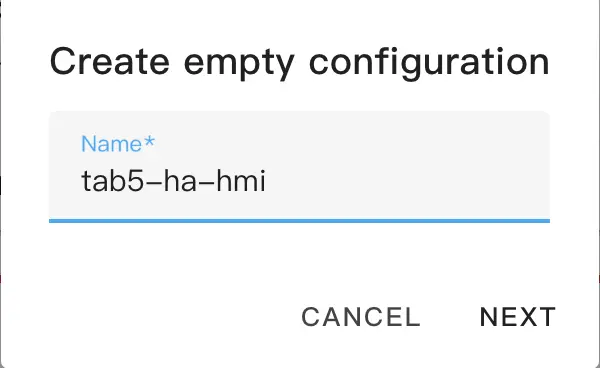
- 在新生成的配置文件处点击
EDIT

之后,复制 tab5-ha-hmi.yaml 的内容到配置文件中
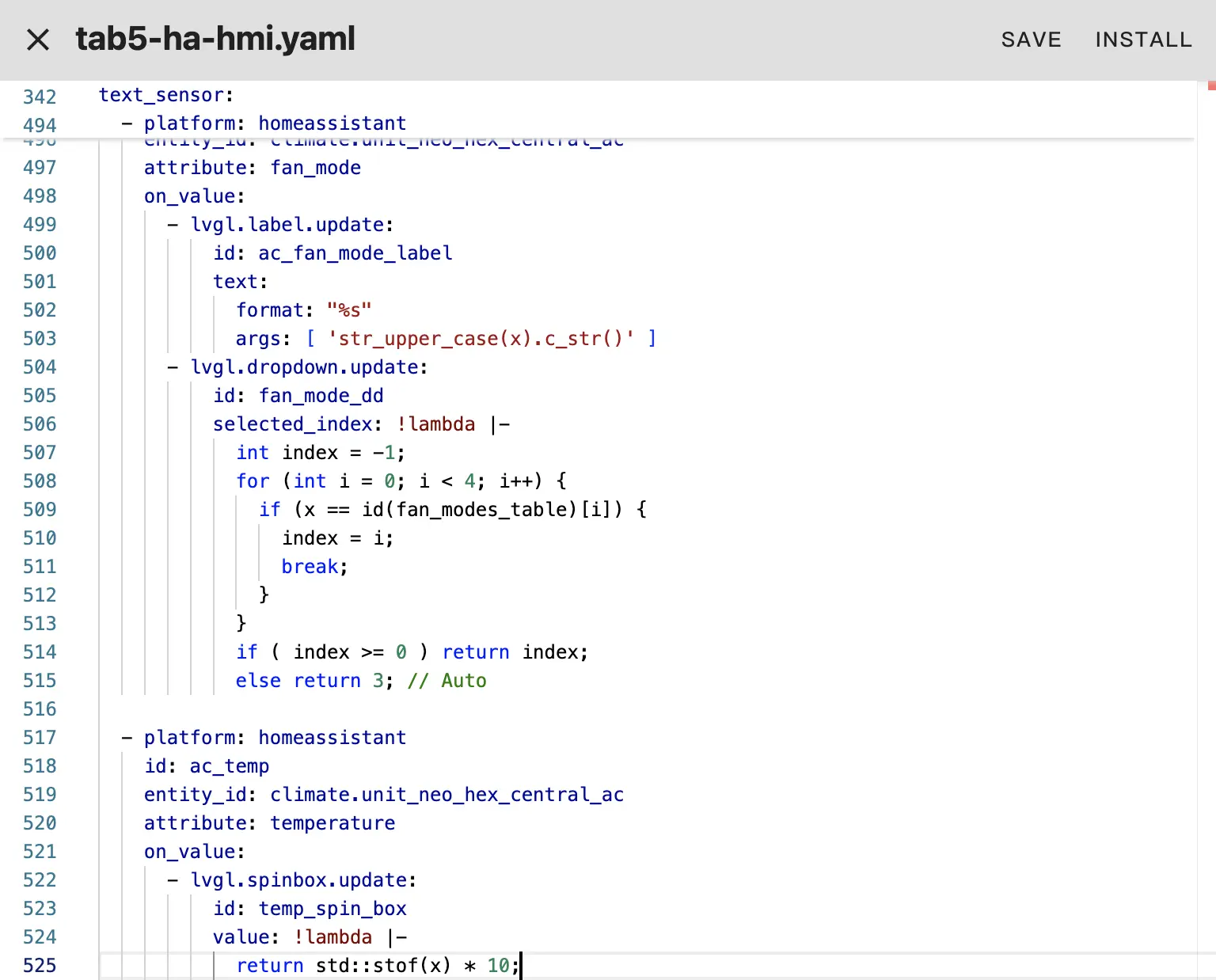
根据需要,更改网络配置或者是 API 信息,比如创建一个 API Encryption Key 用于认证:
api:
encryption:
key: "Your_Encryption_Key"之后,依次点击右上角 SAVE 和 INSTALL,选择 Manual download
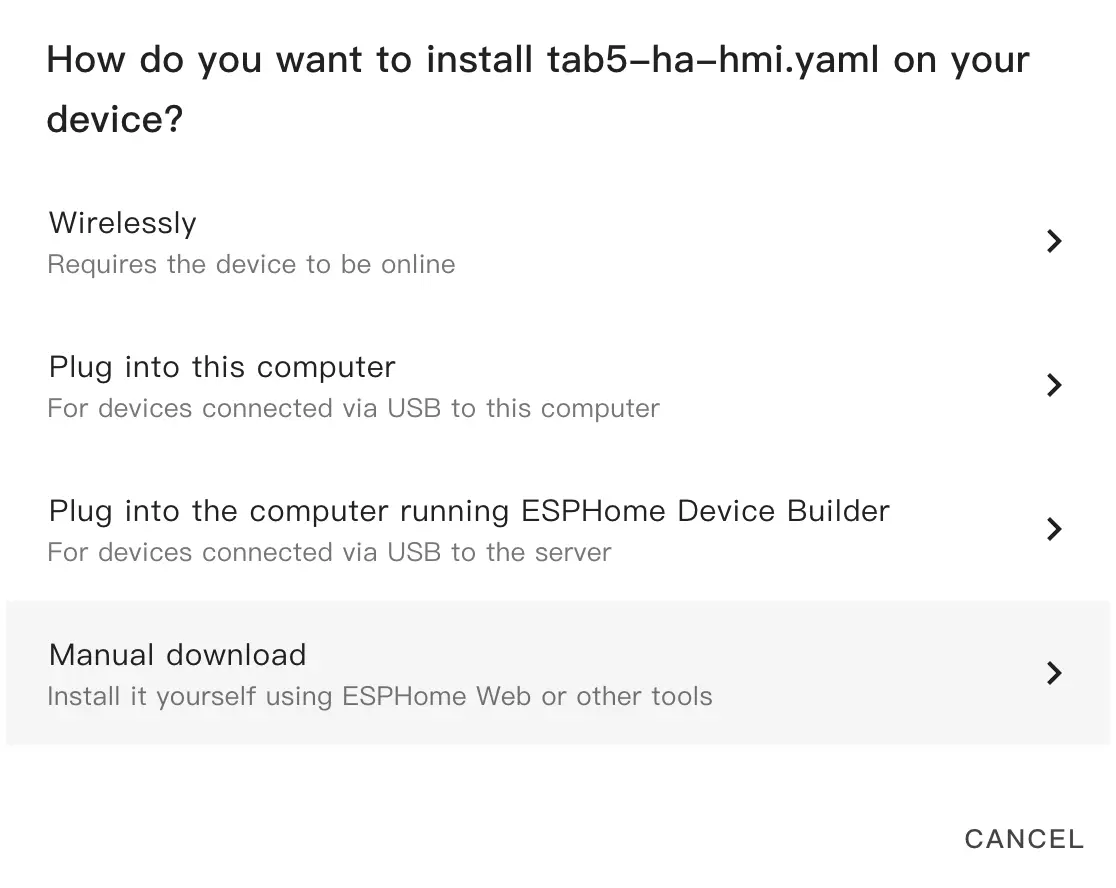
此时会生成代码并且编译工程
当编译完成后,选择 Factory format 下载固件
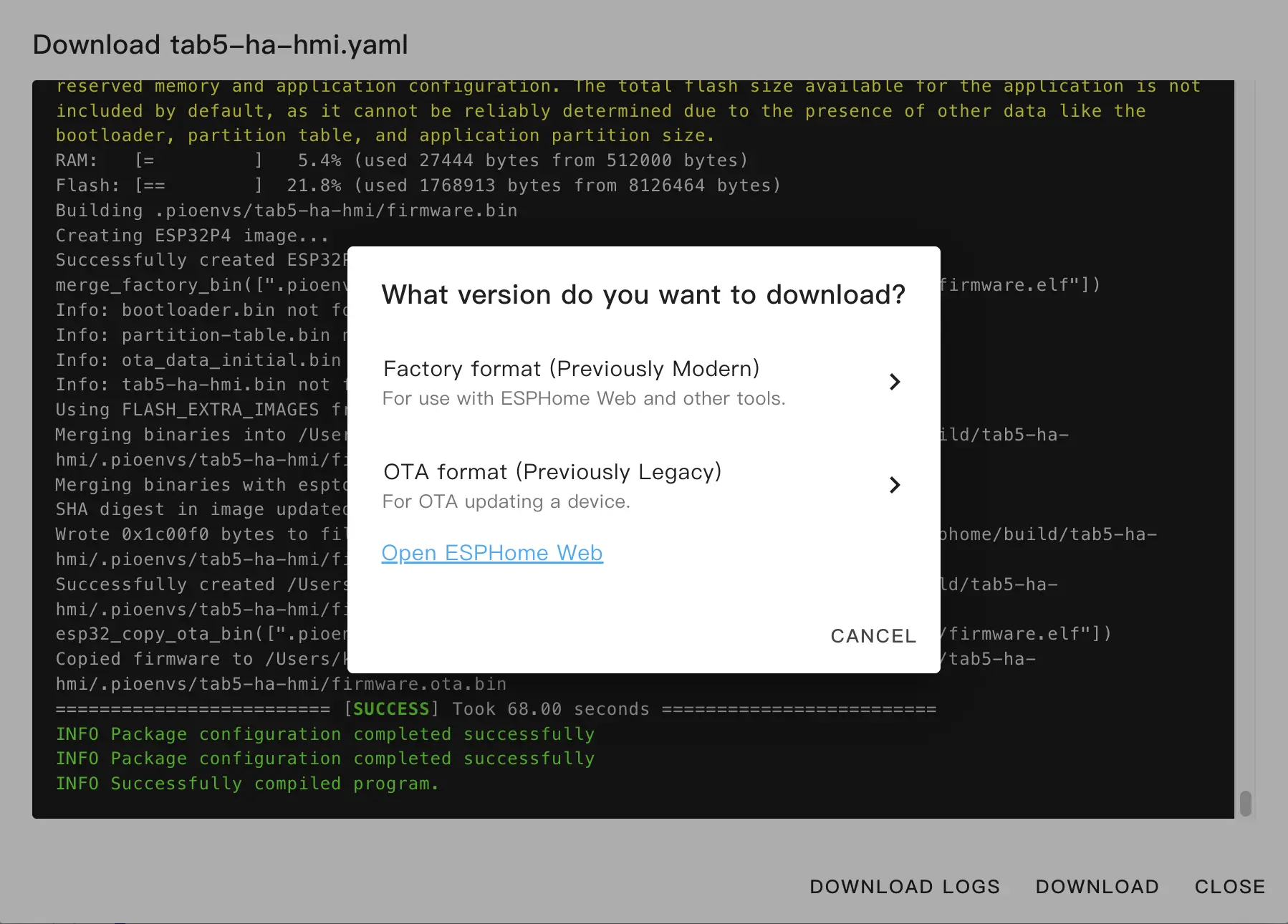
上传固件
打开浏览器,访问 ESPHome Web 上传固件
使用 USB-C 数据线将 Tab5连接至主机, 点击 CONNECT ,选择设备连接
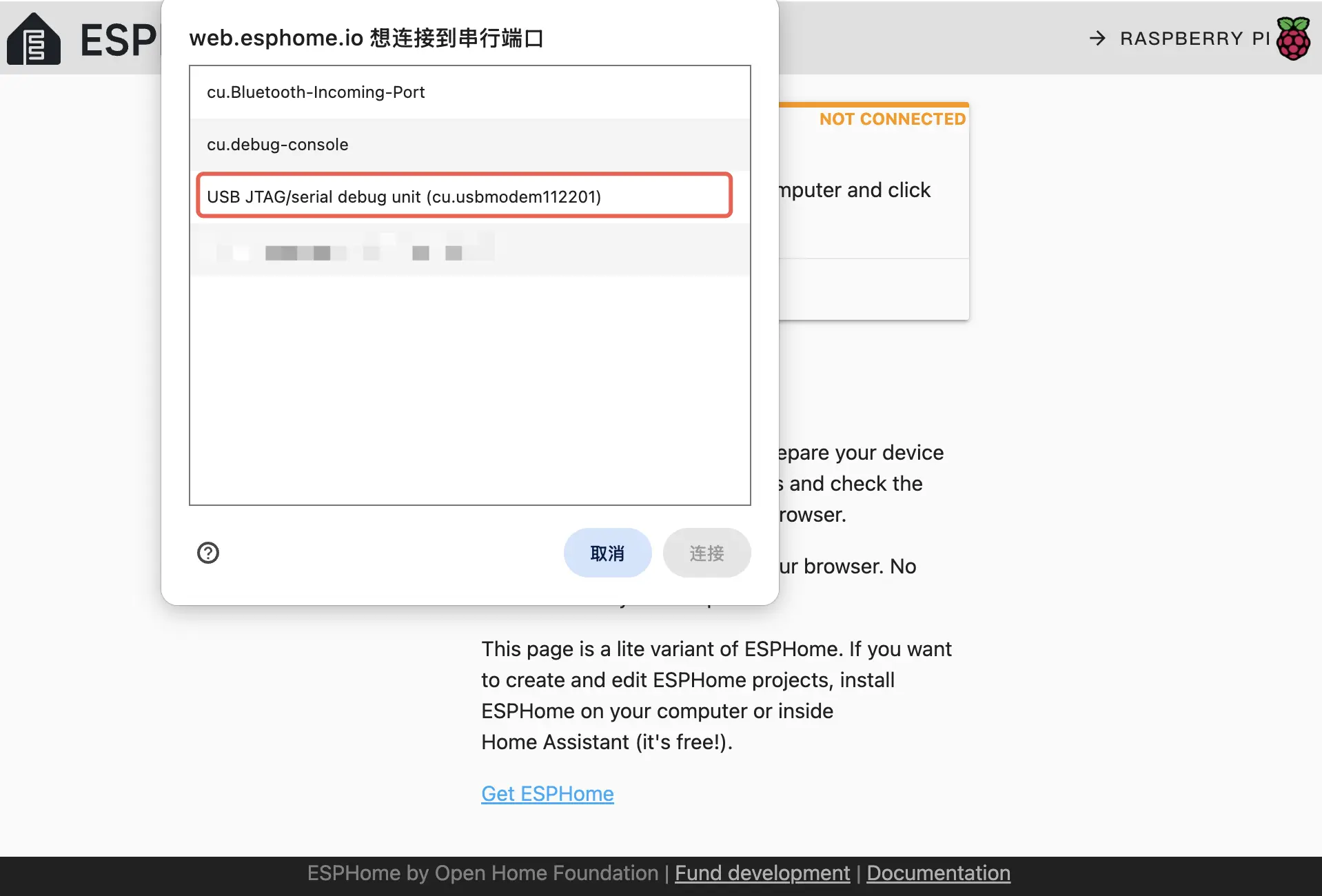
之后,点击 INSTALL,选择之前下载的固件上传,再次点击 INSTALL,将固件烧录至设备。
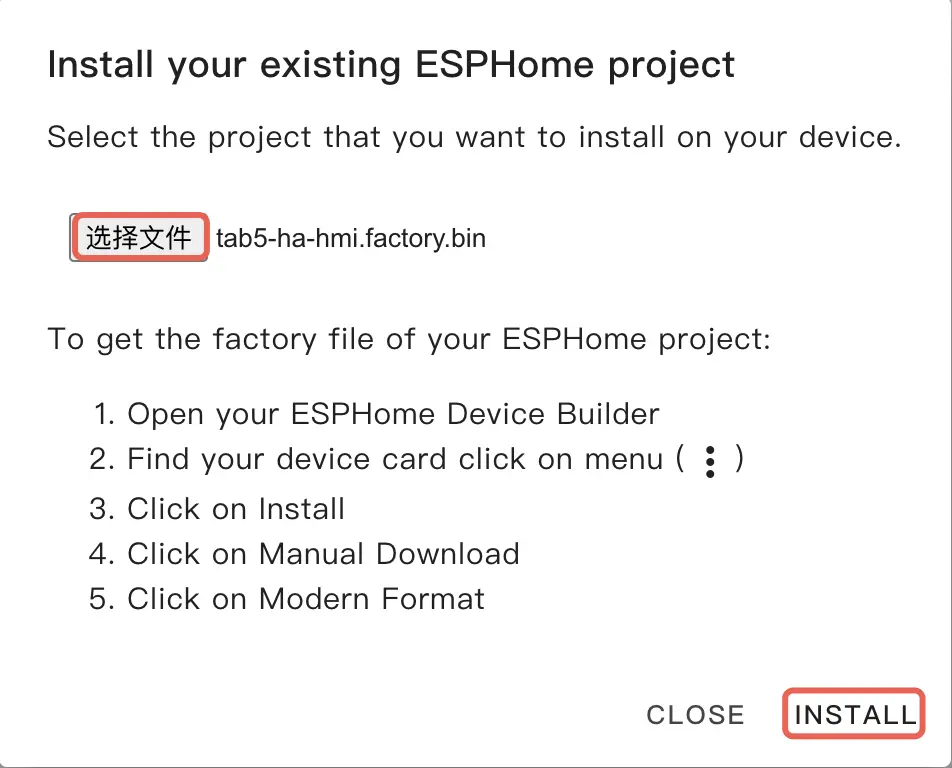
当烧录完成后,设备会自动重置
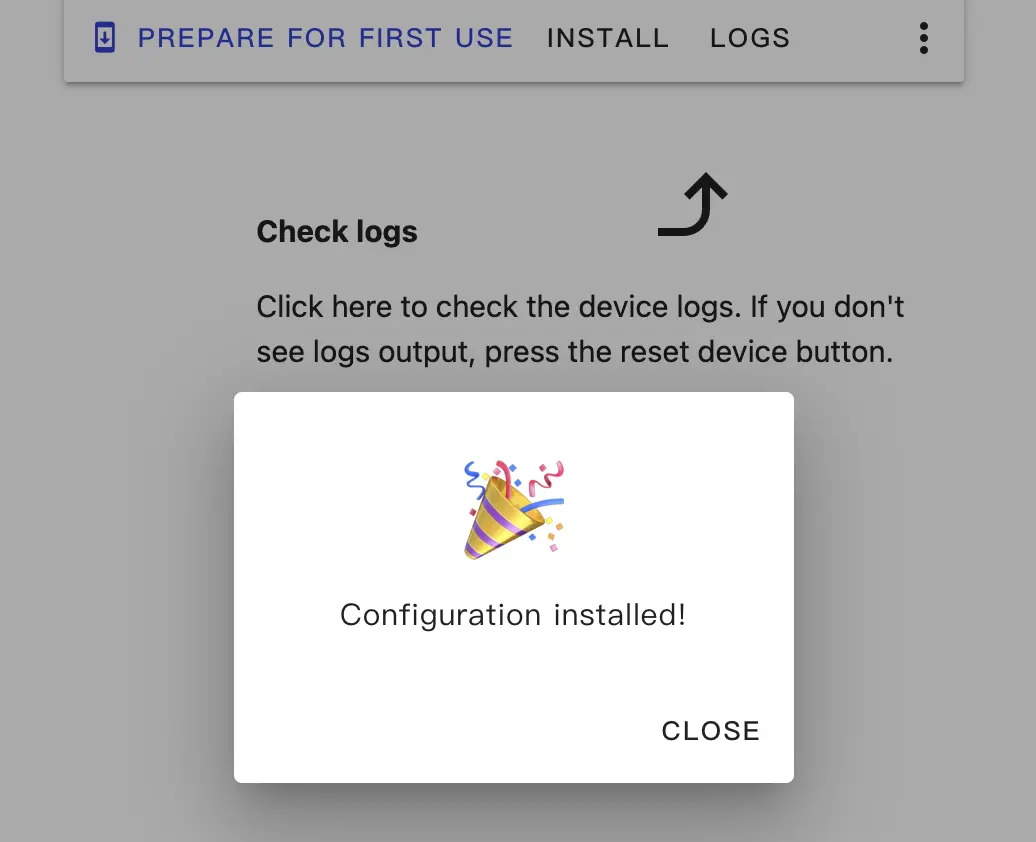
HMI 集成
当设备重启后,会自动连接之前配置的网络,正常情况下可以在 Settings -> Devices & services 发现设备
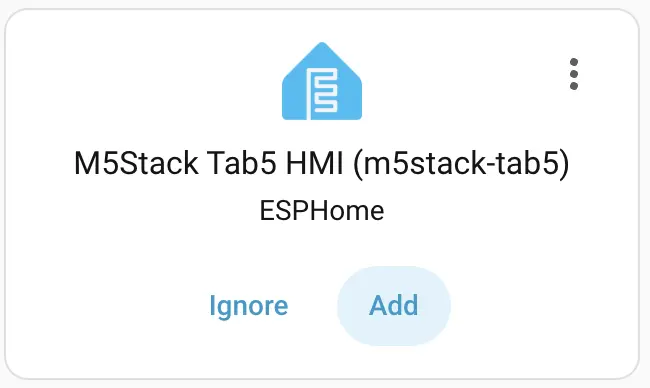
点击 Add 将 Tab5 集成进入 Home Assistant,如果此前设置了 API Encryption Key ,此处可能需要填入 API Encryption Key 验证
Tab5 的 Dashboard 示例

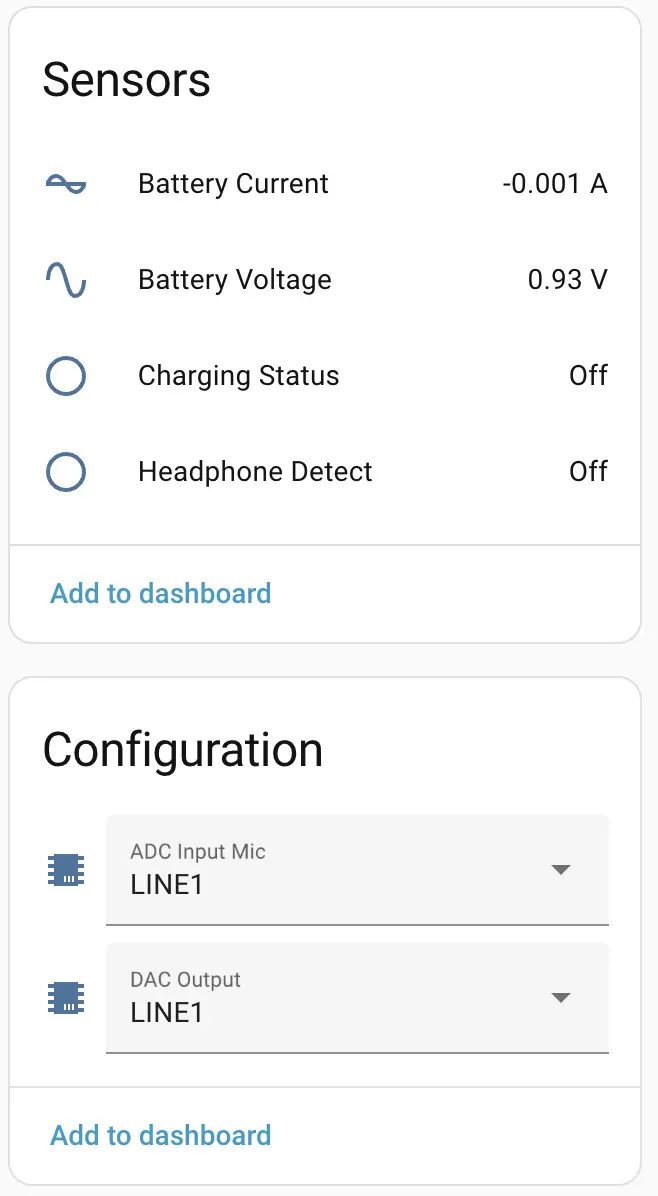
允许 Tab5 执行 Home Assistant Action
当设备添加完成后,在 Home Assistant 中点击 Settings 会发现一个待修复的问题

查看详情
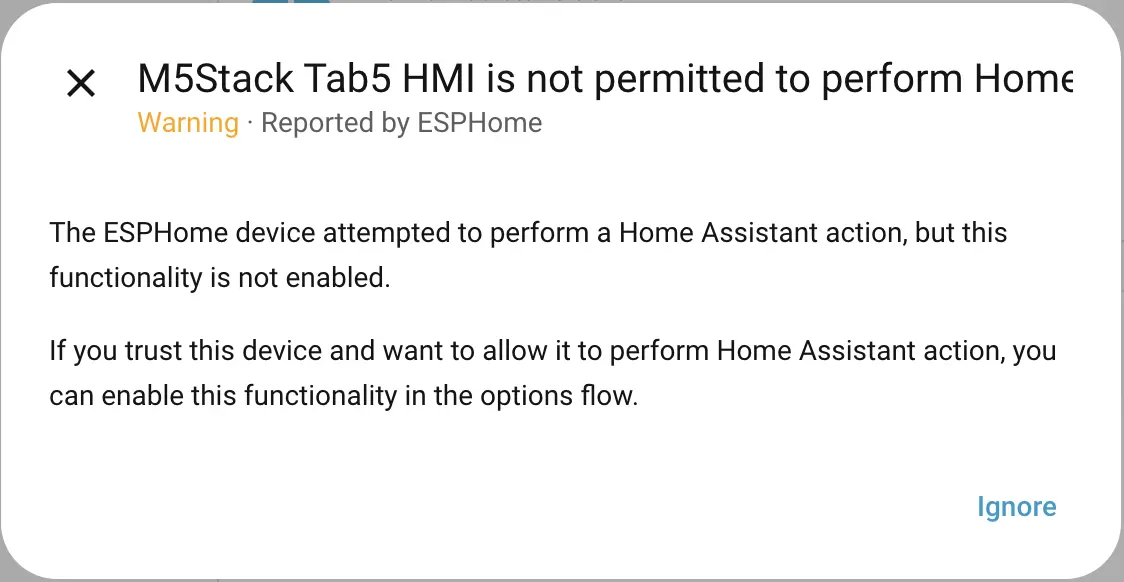
该问题告诉我们, Tab5 尝试访问 Home Assistant 上集成的实体并且修改某些属性,但是默认情况下 Home Assistant 不允设备许执行操作
解决方案:
打开 Settings -> Device & services -> ESPHome,找到 Tab5 设备

点击右上的设置图标,勾选 Allow the device to perform Home Assistant actions
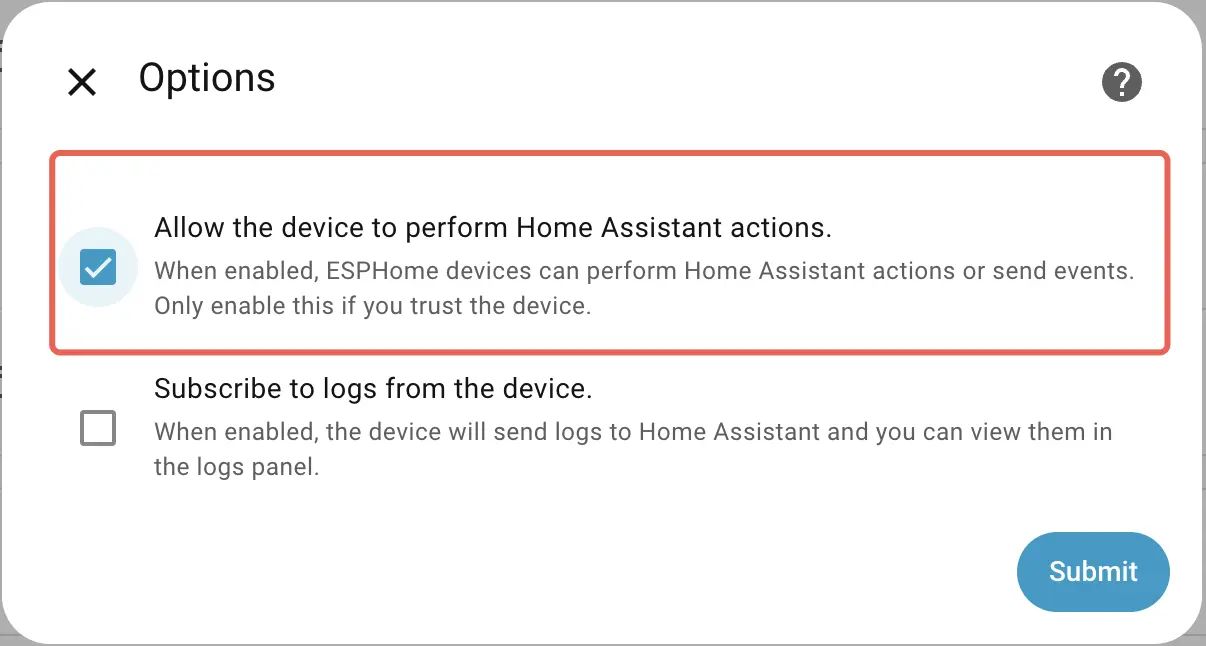
点击 Submit

自此 Tab5 就能控制已经配置的 Home Assistant 实体
HMI 使用方法
UI 主要是按照 Pages 分页展示,目前有三个页面,可以通过左侧 Sidebar 导航。Dashboard 页面主要展示一些简单信息,灯光页面可以操作某个具体的灯光实体,Climate 页面可以操控某个具体的空调。
UI 设计和交互参考自 Home Assistant dashboard,在嵌入式设备上使用LVGL实现可能需要更多时间
点击侧边栏的 Light 按钮,可以看见一个示例灯光

单击里面的 Icon Button,可以打开/关闭灯光
如果点击卡片的空白区域,可以打开灯光控制的模态框用于控制灯光亮度和RGB色彩
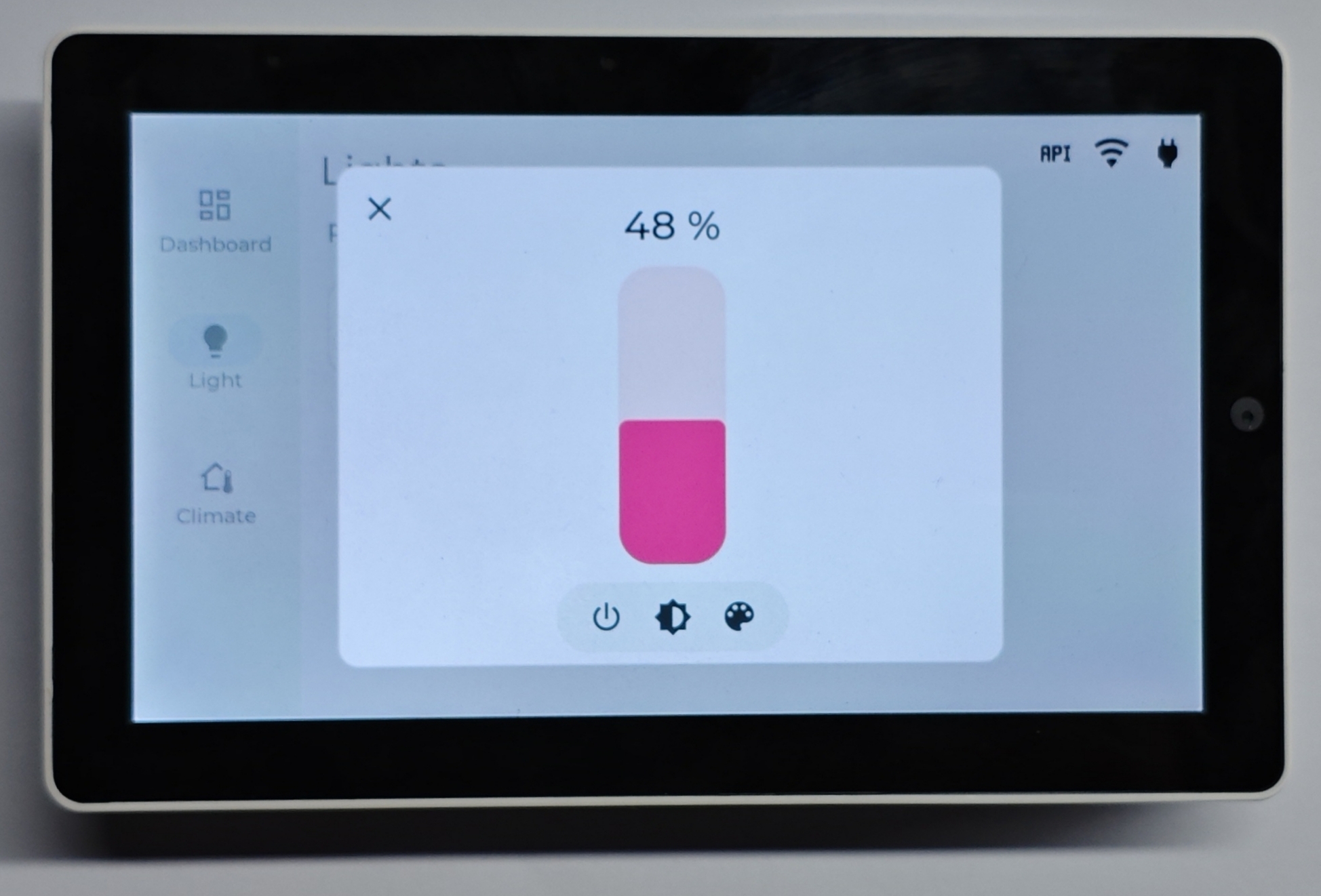
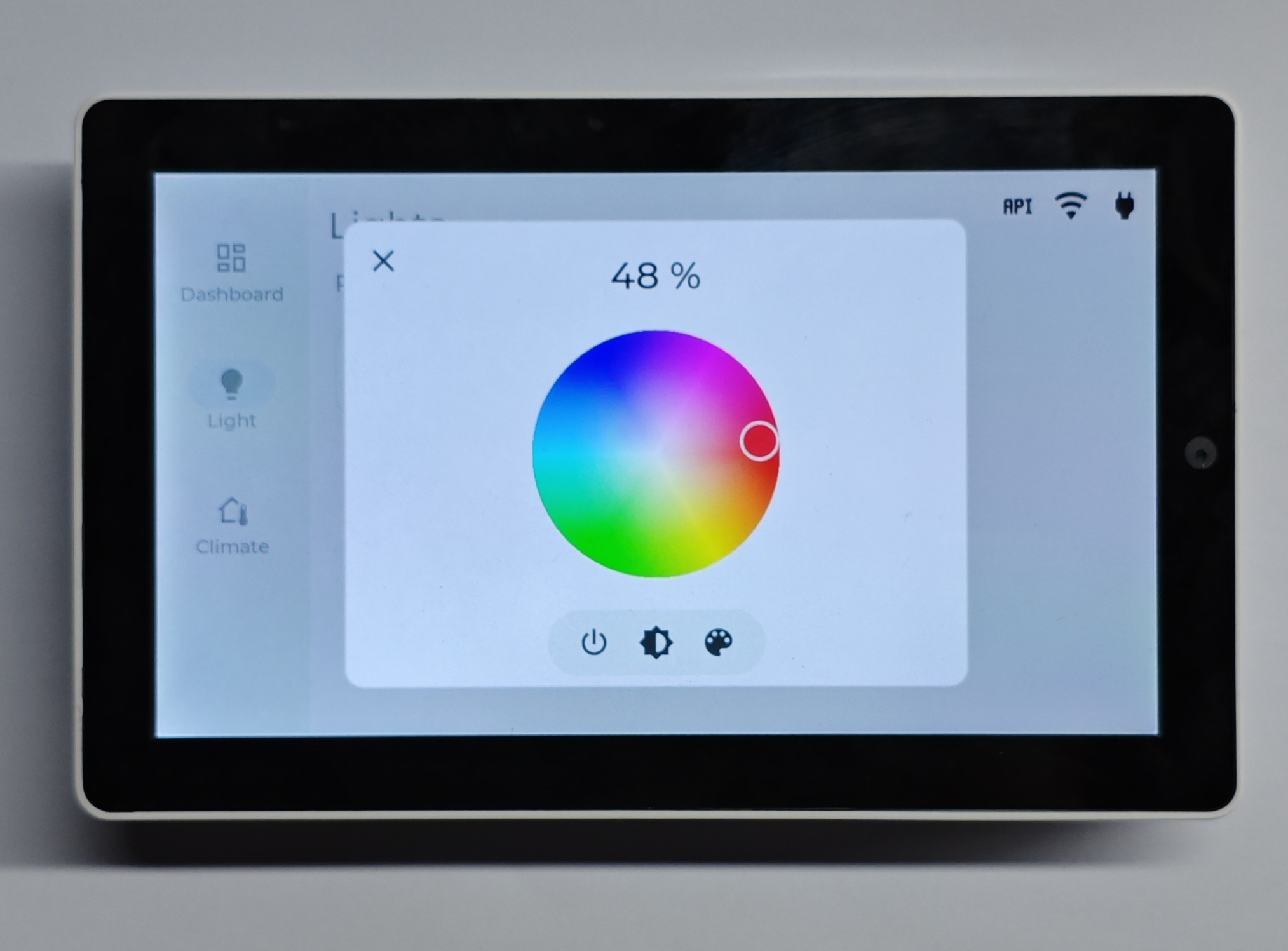
点击左侧的 Climate 按钮,会出现一个示例的空调
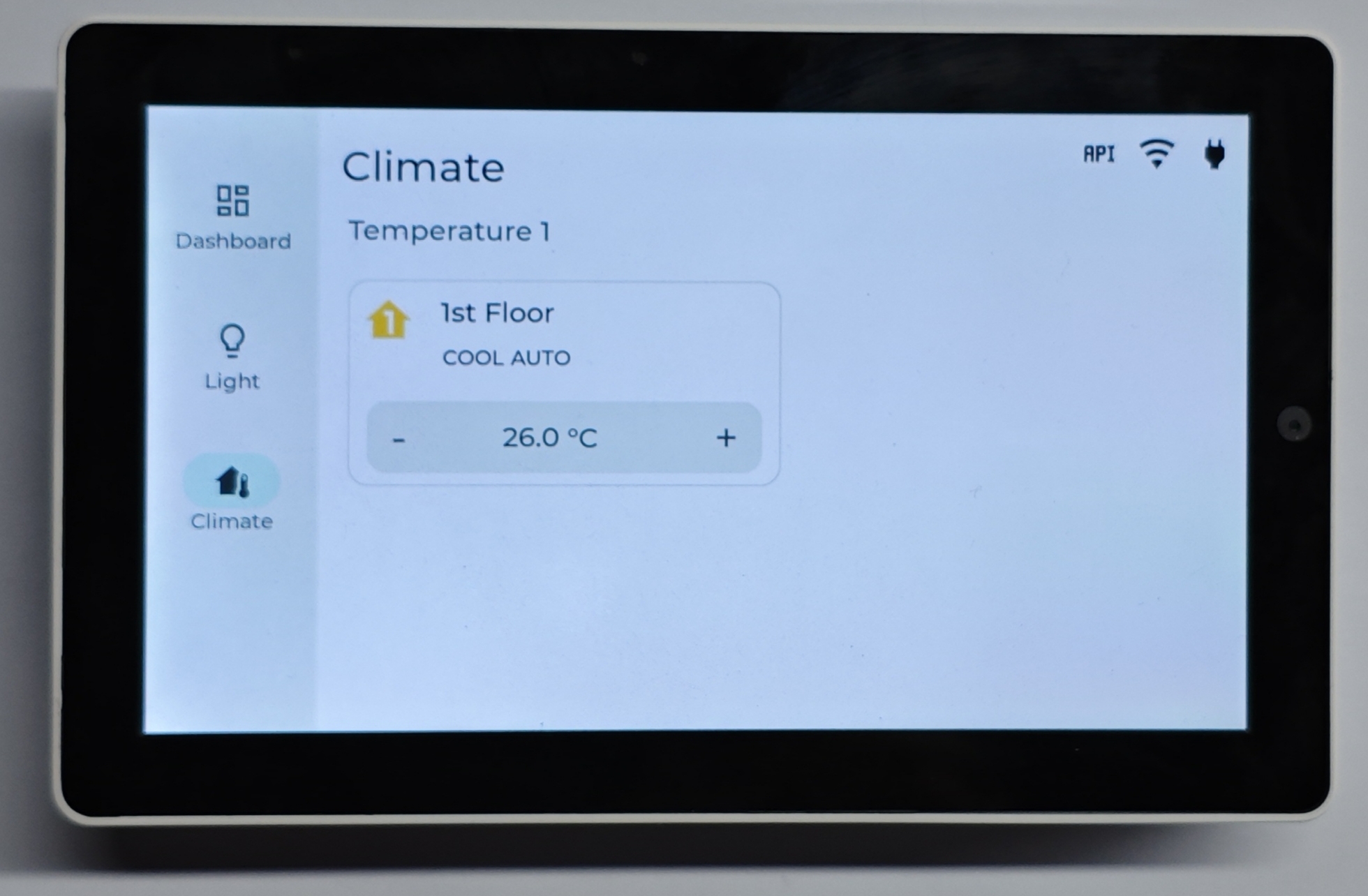
点击 Spinbox 两边的 + 和 -,会调整空调的目标温度(但无法设置空调状态,比如自动/制冷/制热等)
点击卡片的空白区域会打开模态框,用于调整模式,风速和温度等
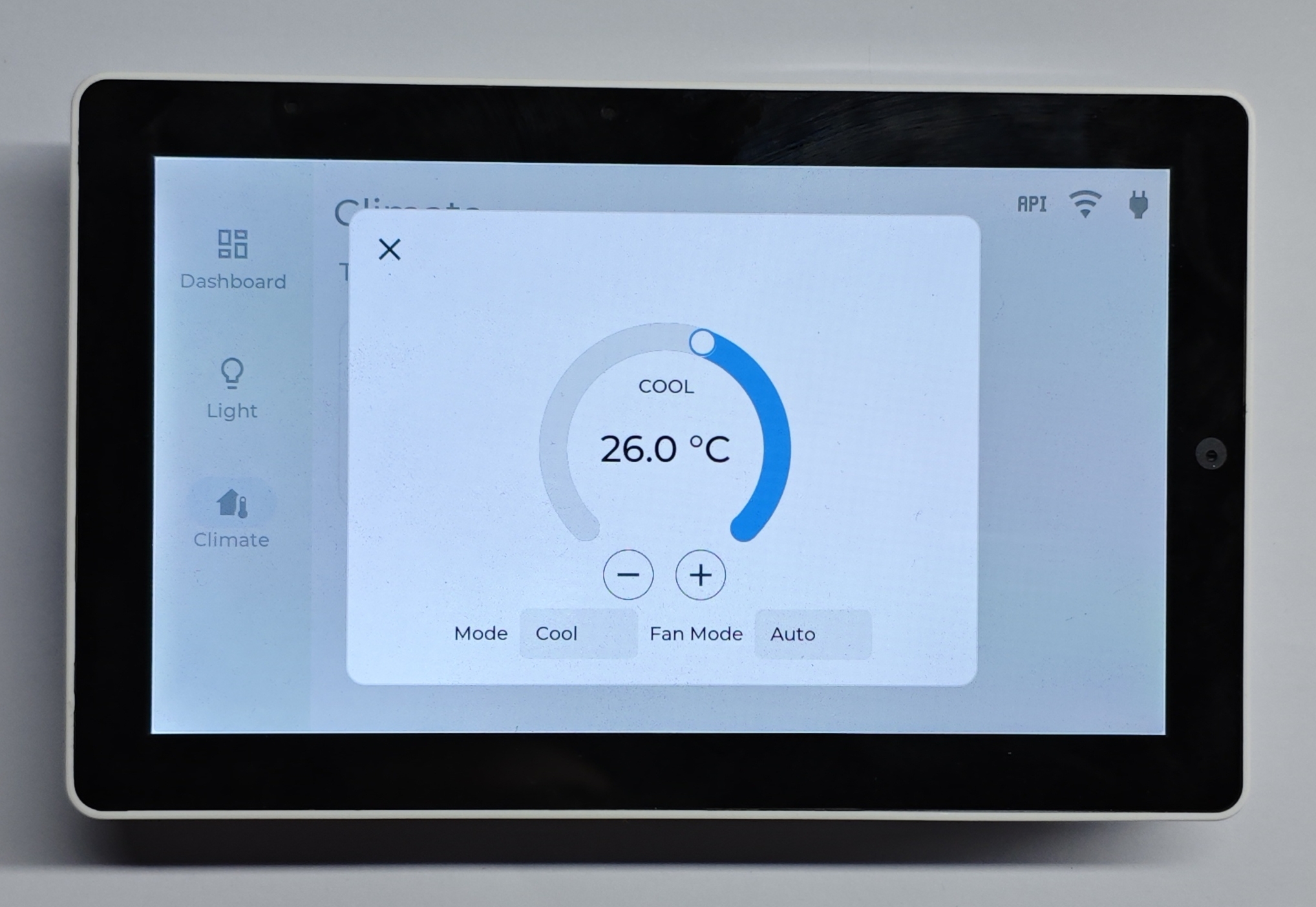
调整配置
这一部分将介绍如何修改配置,您可以尝试将自己的灯光、空调等组件配置到 Tab5 中,此部分仅针对有 ESPHome 使用经验的用户,在此之前,可以参考 ESPHome 提供的集成方式:
Remote light button 介绍了如何添加一个 LVGL 的灯光按钮,使其可以远程控制一个灯光实体
Toggle state icon button Remote light 的进阶版本,可以根据灯光开关情况修改 LVGL UI
Light brightness slider 介绍了如何绘制一个 LVGL Slider 并且绑定灯光亮度
Native API Component 介绍了如何通过
homeassistant.action来调用 Home Assistant,其中包含了一个设置 RGB 灯光颜色的案例Climate control 介绍了如何创建一个 LVGL Spinbox 并且控制如空调/加热器等实体
Home Assistant Text Sensor 特殊的 Text Sensor 类型,用于获取 Home Assistant 上实体的状态值和属性值
Home Assistant Binary Sensor 特殊的 Binary Sensor 类型,用于获取 Home Assistant 上的 Binary Sensor 的读数
Home Assistant Sensor 特殊的 Sensor 类型,用于获取 Home Assistant 上的 Sensor 实体的读数
了解了上面这些案例后,我们就可以大概绘制出目前的一个架构
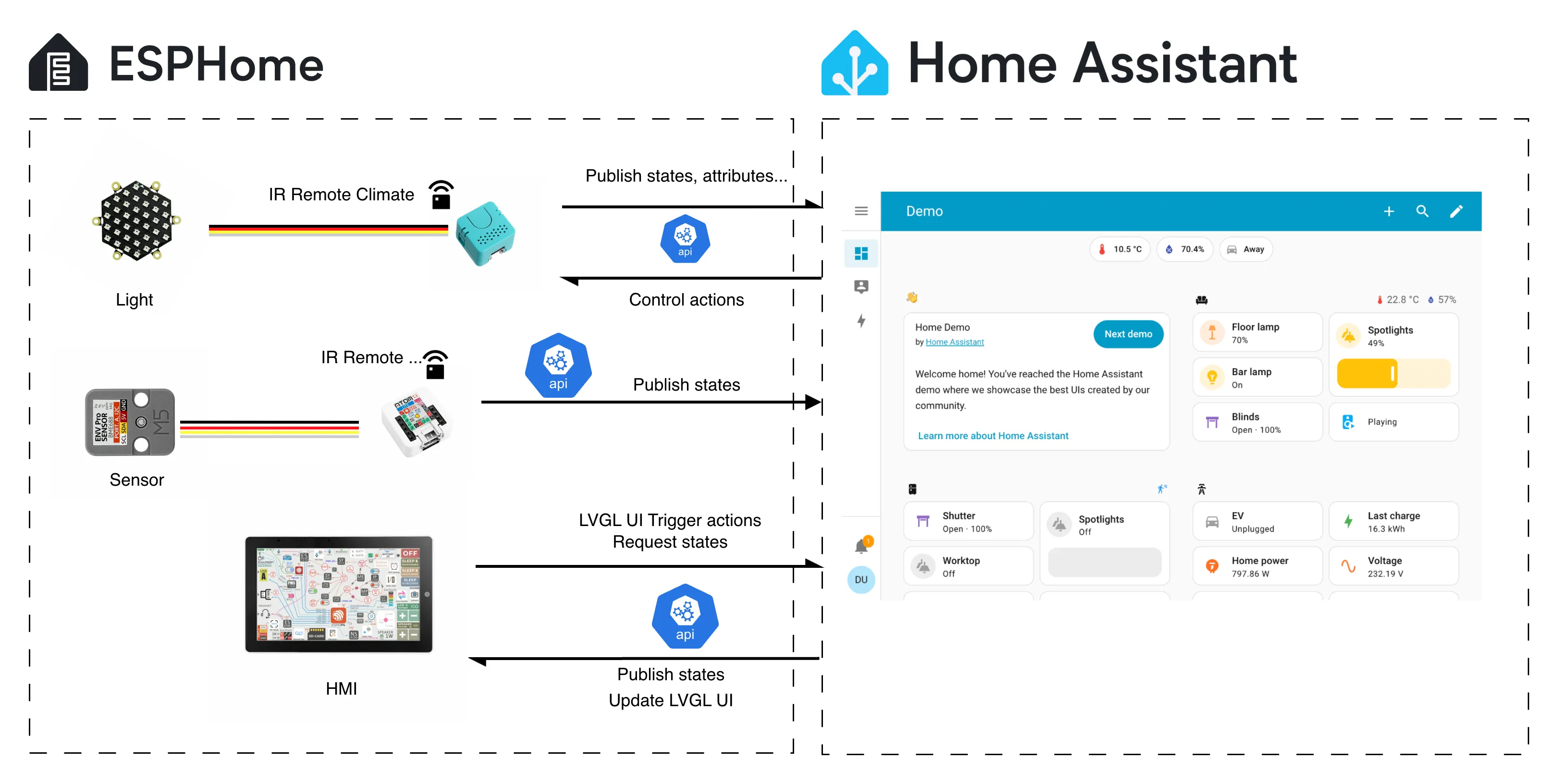
灯光
下面就以灯光组件作为一个范例。
在 LVGL (主要定义在 tab5-lvgl.yaml 文件) 中,我们绘制了一些组件,譬如 Icon Button,Slider还有一个自定义的 Color Palette (调色盘)。当然在此之前,确保已经将灯光组件集成到了 Home Assistant 中(确保在 Home Assistant 中可以操作灯光)。由于在配置文件中定义的有 text_sensor:
text_sensor:
- platform: homeassistant
id: demo_light
entity_id: light.unit_neo_hex_unit_neohex
on_value:
then:
- lvgl.widget.update:
id: xxx
...
- lvgl.label.update:
id: xxx
...
- platform: homeassistant
id: demo_light_brightness
entity_id: light.unit_neo_hex_unit_neohex
attribute: brightness
on_value:
- lvgl.slider.update:
id: xxx
...
- lvgl.label.update:
id: xxx
...
- platform: homeassistant
id: demo_light_color
entity_id: light.unit_neo_hex_unit_neohex
attribute: rgb_color
on_value:
...
...它有一个 on_value 属性用于自动化 (Automation) 的回调,当接收到 Home Assistant 更新的数据后,便可在其中调用 lvgl 相关动作 (actions) 用于更新 UI 内容。
Developer tools -> States 搜索相关属性(比如输入 light 查找)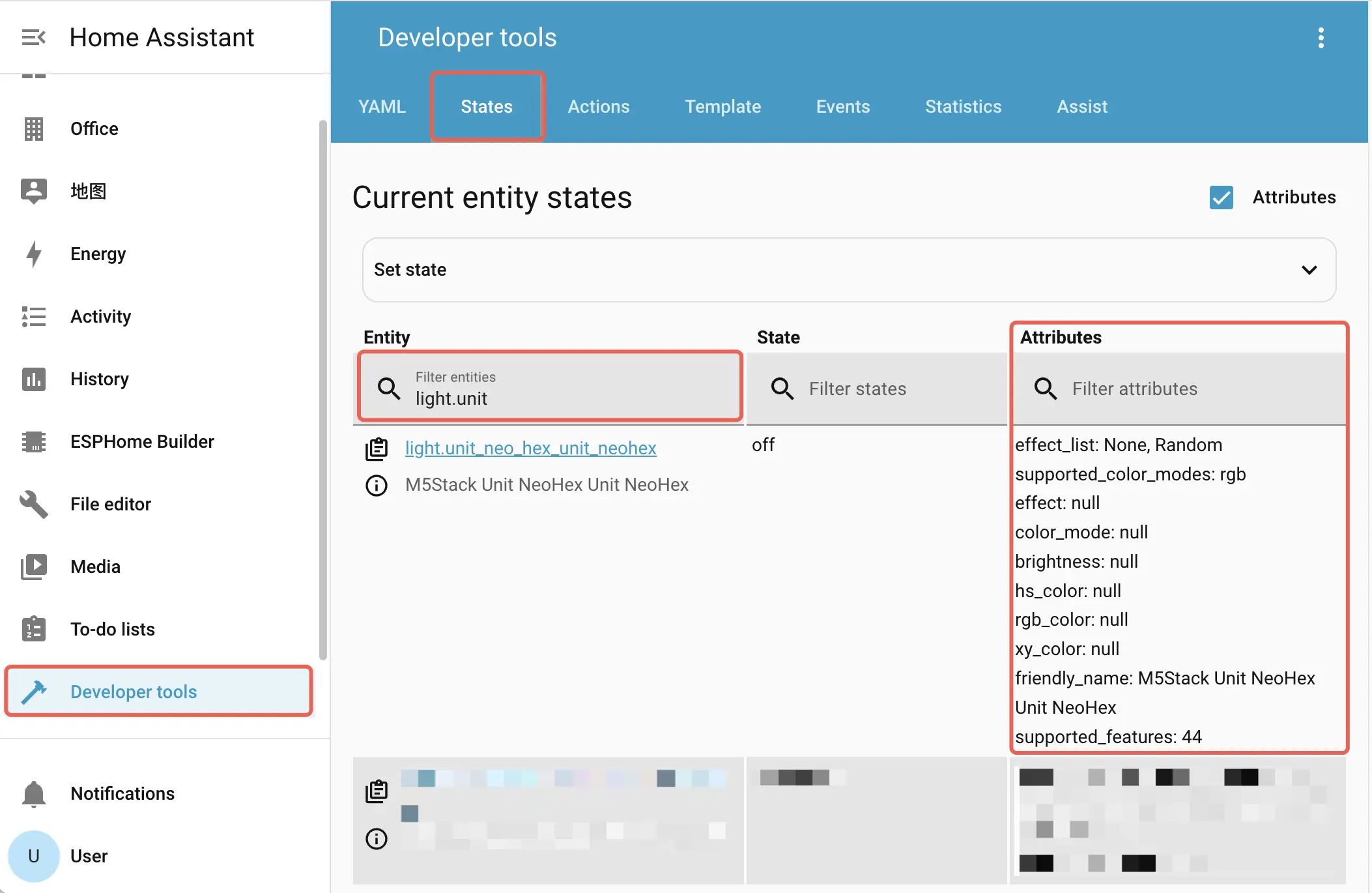
而 LVGL 的组件事件触发 (trigger)可以通过 homeassistant.action API 控制灯光:
# Use a icon button to toggle the light
...
- button:
styles: card_sm_icon_btn
id: demo_light_btn
...
widgets:
- label:
id: demo_light_label
...
text: "\U000F18DE"
align: CENTER
on_short_click:
- homeassistant.action:
action: light.toggle
data:
entity_id: light.unit_neo_hex_unit_neohex
...
# Use a slider to control light brightness
- slider:
min_value: 0
max_value: 255
id: light_slider
...
on_release:
- homeassistant.action:
action: light.turn_on
data:
entity_id: light.unit_neo_hex_unit_neohex
brightness: !lambda return int(x);
...不同 LVGL 组件有不同的触发方式 (Triggers),具体可以参考 ESPHome - LVGL Widgets
data 中直接指定 entity_id 和属性名称进行更改, Home Assistant 会拒绝无效的属性更改,若要知道那些 action 可以被触发,可以打开 Home Assistant 的 Developer tools -> Actions 查看。比如搜索灯光有哪些 action 可以触发,此处 RGB 变色就是由 Home Assistant 脚本触发的,如需了解更多脚本和自动化内容,参考1. Automating Home Assistant
2. Home Assistant Scripts
3. Home Assistant Templating
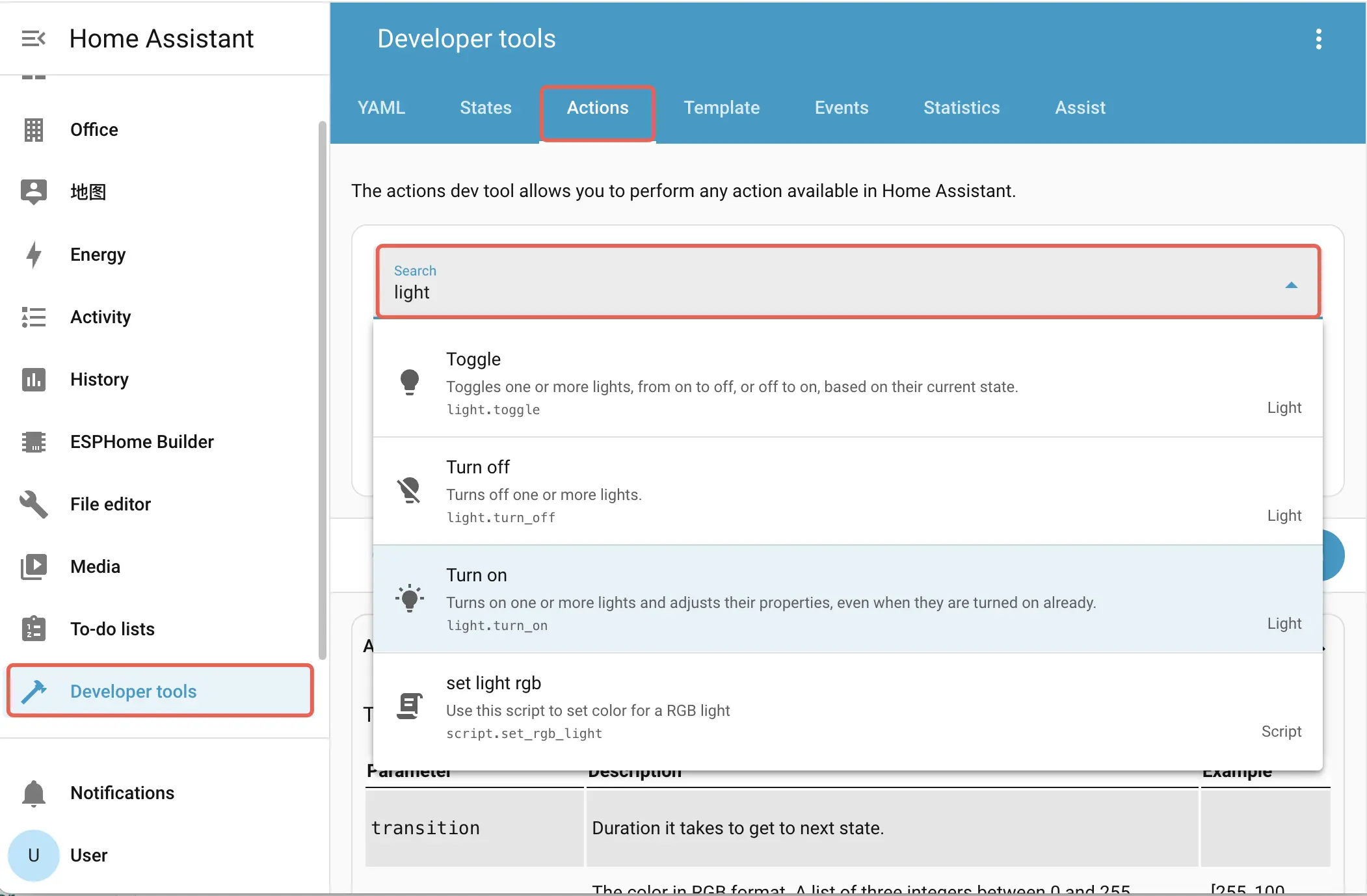
了解了上面这些内容后,如果想使用自己的 Light 实体:
- 在
text_sensor中添加或修改你想更新的entity_id和attribute,如果需要更新 LVGL UI,则需要编写更新的动作 - 在自己希望触发灯光动作的 LVGL 组件回调中,将
homeassistant.action中data下的entity_id修改为合适的 id, 并确保 action 已经存在
传感器
同样,对于传感器 Sensor 实体,其主要是发布数值(当然也有文字,ON/OFF 状态等),所以在配置文件中,如果需要知道 Home Assistant 上某个传感器的数值,也是指定 entity_id 即可
sensor:
...
- platform: homeassistant
id: cur_temp
entity_id: sensor.temperature
on_value:
- lvgl.label.update:
id: xxx
- platform: homeassistant
id: cur_humi
entity_id: sensor.env_iv_kit_humidity
on_value:
- lvgl.label.update:
id: xxx
- platform: homeassistant
id: cur_co2
entity_id: sensor.env_iv_kit_co2_equivalent
on_value:
- lvgl.label.update:
id: xxx
...这样 Tab5 便能读取到 Home Assistant 的传感器数据值,并且通过 on_value 将值更新至 LVGL UI 界面
如需使用自己的传感器,只需修改 entity_id 即可,如需更新 LVGL UI 则还需要编写相应的脚本
Settings -> Devices & services 下的 Entities 找到各种实体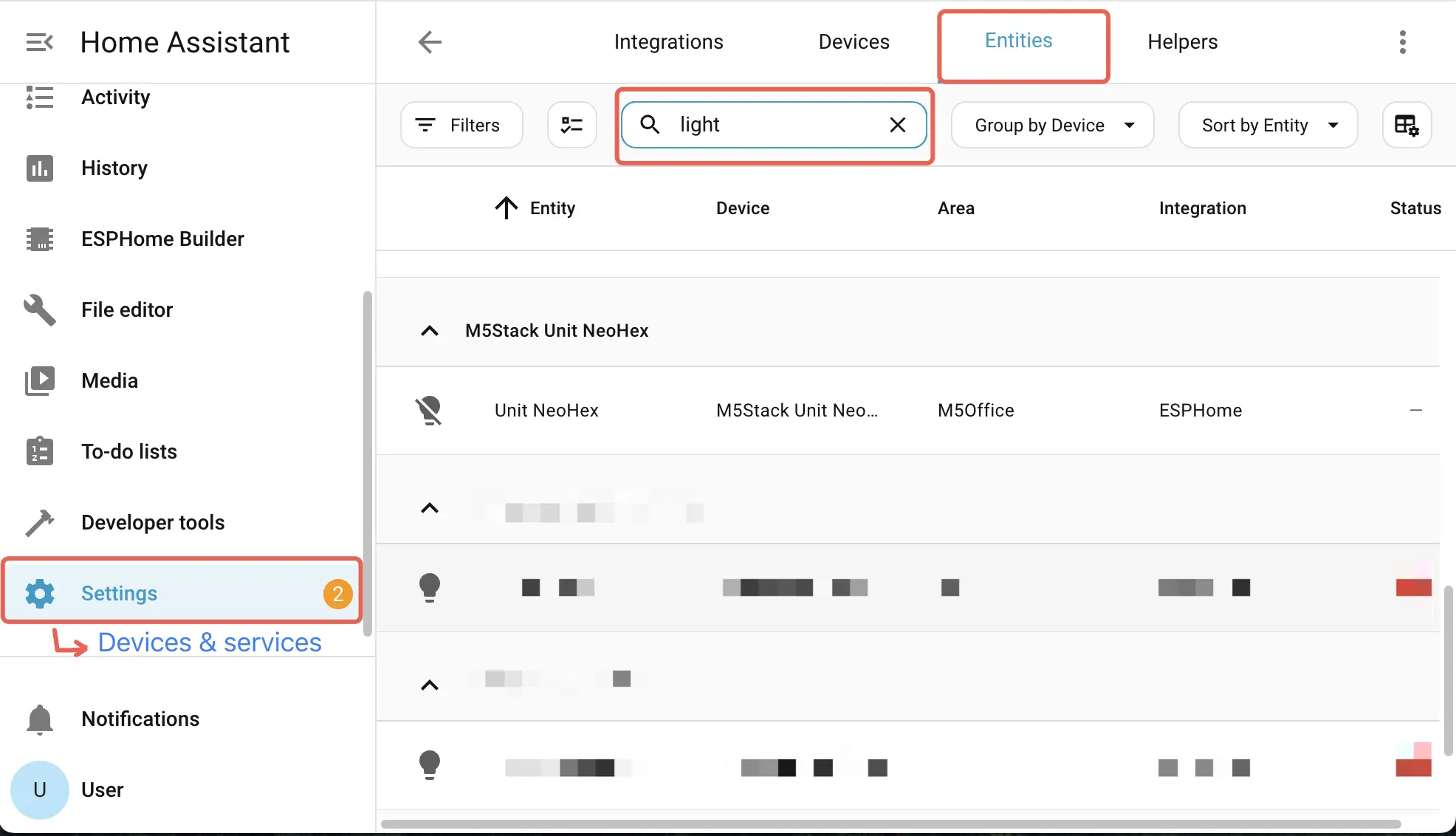
Climate
同样在配置中定义的有一些关于 Climate 实体的属性:
# AC Information
- platform: homeassistant
id: ac_state
entity_id: climate.unit_neo_hex_central_ac
on_value:
- lvgl.label.update:
id: xxx
- lvgl.dropdown.update:
id: xxx
...
- platform: homeassistant
id: ac_fan_mode
entity_id: climate.unit_neo_hex_central_ac
attribute: fan_mode
on_value:
- lvgl.label.update:
id: xxx
- lvgl.dropdown.update:
id: xxx
...
- platform: homeassistant
id: ac_temp
entity_id: climate.unit_neo_hex_central_ac
attribute: temperature
on_value:
- lvgl.spinbox.update:
id: xxx
...一样可以获取到这些属性,然后更新到 UI 上。
LVGL UI 控制 Climate 组件:
...
- arc:
id: ac_arc
adjustable: true
...
# Prevent frequent use of 'on_value'
# In case of performance issue
on_release:
- lambda: id(set_ac_temp)->execute(float(x) / 10.0f);
...
- dropdown:
id: ac_mode_dd
...
dir: TOP
selected_text: "Off"
options:
- Heat_Cool
- Heat
- Cool
- Dry
- Only Fan
- "Off" # In case conversions
on_change:
...
- lambda: id(set_ac_state)->execute(x);
- dropdown:
id: fan_mode_dd
dir: TOP
...
selected_text: "Auto"
options:
- High
- Medium
- Low
- Auto
on_change:
...
- lambda: id(set_ac_fan_mode)->execute(x);这里将控制封装成了脚本,可以在 tab5-scripts.yaml 中找到
# This script was used on dropdown widget
# to set ac state (ON/OFF/COOL/HEAT, etc)
- id: set_ac_state
parameters:
ac_mode_idx: int
then:
- homeassistant.action:
action: climate.set_hvac_mode
data:
entity_id: climate.unit_neo_hex_central_ac
hvac_mode: !lambda return id(hvac_state_table)[ac_mode_idx];
- id: set_ac_fan_mode
parameters:
ac_fan_mode_idx: int
then:
- homeassistant.action:
action: climate.set_fan_mode
data:
entity_id: climate.unit_neo_hex_central_ac
fan_mode: !lambda return id(fan_modes_table)[ac_fan_mode_idx];
# This script was used on spinbox/arc widget
# to set the temperature to climate entity
# it doesn't turn on/off, use the dropdown instead
- id: set_ac_temp
parameters:
temp_value: float
then:
- homeassistant.action:
action: climate.set_temperature
data:
entity_id: climate.unit_neo_hex_central_ac
temperature: !lambda return temp_value;同样,如果想要适配自己的 Climate 组件,可以修改 entity_id 和相关属性。
